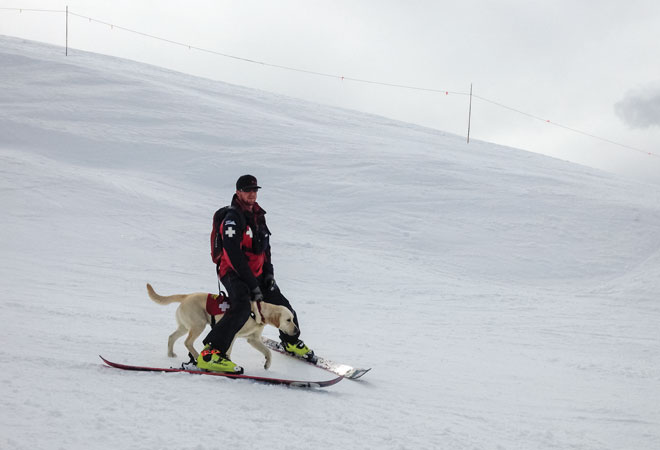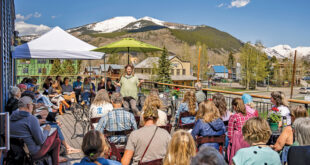“We patronize the animals for their incompleteness, for their tragic fate of having taken form so far below ourselves. And therein we err, and greatly err. For the animal shall not be measured by man. In a world older and more complete than ours, they move finished and complete, gifted with extensions of the senses that we have lost or never attained, listening to voices that we shall never hear. They are not brethren, they are not underlings; they are other nations, caught with ourselves in the net of life and time, fellow prisoners of the splendor and travail of the earth.”
—Henry Beston, The Outermost House
There’s a reason for the phrase “working like a dog.” There’s a type of dog that goes beyond the best friends, constant companions, and family members of house pets—they’re working dogs, entirely focused on their jobs. From assist dogs to avalanche dogs, ranch dogs to mushers, covering a diverse variety of breeds, all are highly trained.
First, What is a Service Dog?
There’s a distinction between the behavior of actual service dogs and what might be considered impostors. A true service dog is trained to become essentially invisible and their assistance to their owner is indispensable.
On the other hand, a pet whose owner merely ordered and paid for a service animal vest and the accompanying identification card online so their animal could pose as a service dog, might bark, urinate, disrupt, and even attack other pets and people in public.
Under the Americans with Disabilities Act (ADA), it’s a federal crime to represent a dog as a service animal if it is not.
The law says people entering businesses with animals can be asked just two questions: Is this a service dog? What is it trained to do for you?
Whether it’s someone who wants to skirt the law to take their dog everywhere or live in a place that doesn’t allow their pet, these fake vested animals cause damage to the real service dogs and disabled community. Colorado is definitely a dog-friendly state, but the Colorado House unanimously passed a bill that would make it a crime to misrepresent a pet as a service animal.
guide dog
A hearing assistance dog should be able to differentiate sounds like a baby crying, someone knocking at the door, or a phone ringing and lead their owner to the source of that sound. Guide dogs should be able to lead a blind person through traffic and crowds. Sarah Jones is helping make the latter a reality.
On ski patrol for 20 years, and having trained two avalanche dogs, Sarah decided to train a seeing-eye dog for Guide Dogs of America (GDA). She got Kip as an adorable eight-week-old puppy.
“The hardest thing was asking people not to pet the puppy. I signed a contract with GDA, who gave us the puppy to raise,” Sarah says of Kip, with his snuggly black lab face. “There were a lot of rules, leash and obedient rules, and when it was okay to say hello to a person.”
Every month Sarah drove to Cañon City to attend a puppy group for guide dogs. Before she even got Kip, she had to attend multiple pre-puppy meetings. She picked up Kip in December 2015, and raised him for 16 months. “My training with Kip was general. We rode the bus, and we practiced restaurant etiquette,” which meant, like all service dogs, Kip must learn to lie quietly under the table when his owner is eating.
“He does a pretty good job for being a rambunctious puppy. You teach him to sit right at your feet, because they have to do that with their owners.” When Kip wasn’t in his work uniform, his service dog vest, he was just a dog in the house. “When he was in his vest, which was ‘Puppy in Training,’ he behaved differently. He was slightly better in his vest,” because puppies still have puppy energy. She kept Kip in his vest as much as possible when he was in public.
Sarah dropped Kip off in Sylmar, Calif. at Guide Dogs of America when her part of his training was completed and the next intense phase of Kip’s training would begin. “They call it puppy college,” she says, and as hard as it must have been, she feels, “If he passes we’re really going to be excited because he’ll go on to someone who really needs him.”
Sarah doesn’t know how Kip is going to do now that his training is continuing in depth. She doesn’t know if he’ll succeed, and additionally, he has to pass a medical test for joints, disease and allergies. “We have to be prepared to take him back if he doesn’t pass. Ultimately, I want him to go on to be a seeing-eye dog. However, if he doesn’t make it, we’ll take him back and make him a Crested Butte dog. In this town, dogs go everywhere, but not everybody loves animals, so I found that part to be challenging with a rambunctious dog. It’s been a good experience. Raising dogs is good for the soul. You couldn’t ask for a better life for a dog.”
avalanche dog
Having trained her last dog, Thor, as an avalanche search dog, Sarah recalls the time she was an exchange patrol for a season in Courchevel, France, and Thor had a live find in an avalanche rescue.
“Thor was a joint effort between me and [fellow ski patroller] H-Bomb and the ski patrol.” Describing the rest of the local canine team, Sarah says, “Guinness is the rock star searcher and really good at his job. Moose is a special soul. He’s the dog everyone wants. They’re both hard workers, and both are handsome schmansome,” she laughs.
“The dogs are special at work and they have a special life. They’re the PR dogs, the working dogs, and the life of a patrol dog is great. The ski patrollers who take their dogs to work have a special and unique bond between their dog and themselves.”
There are currently four trained avalanche rescue dogs on ski patrol, Moose, Guinness, Penny, and Ziggy, and the new kid on the block, who’s just starting his training, is patroller Karl Plambeck’s puppy, Star.
Dustin Brown has been on CBMR’s ski patrol for 13 years. The avalanche rescue dogs are trained by the patrol team. His dog is Moose, but all the dogs and handlers work together.
Russ Reycraft is lead trainer and head of department who trained everyone else on patrol. Russ has had two or three dogs in the program, according to Dustin, and he’s trained all of them. Russ went to Canada to work with the Canadian Avalanche Rescue Dog Commission (CARDA), which is considered the best, so CBMR Ski Patrol adopts those standards.
Russ returns from all the programs and training to share the knowledge with the other patrol handlers and together they train the elite dog team. The Crested Butte Ski Patrol also hosts a dog school, a weeklong training session that invites other resort patrollers, although most attend from Colorado.
“We have the Canadian CARDA instructors validate our dogs,” and Dustin points out, “Handlers can pass, but a dog can fail, or vice versa.”
The patrol begins training the dogs as soon as they get them. Star was on the mountain at 10 weeks old and Moose was almost eight weeks. Dustin says, “It’s a year-round project. We work on searches and wilderness stuff with them. We can train for avalanche rescue in the summer, especially when they’re young. The dogs start with simple hide and seek games.” With avalanche victims, the dogs are searching for a scent that percolates up from the snow.
“So we work with live people because you want them to find a live burial. In the beginning, we start with people hiding and eventually, by the time the dogs are fully validated, they’re finding an article of clothing or equipment about three feet deep, representing a deep burial for an actual person. The dogs fire on the scent of a real person buried because there’s a large scent. We do bury people on occasion, especially early in the dogs’ training, otherwise a backpack or sweater.”
Dogs are trained to ride lifts, snowmobiles, and toboggans. Most days the dogs and their handlers ride the chair lift up. There’s also the dog box pulled behind a snowmobile for the ride down. “The safest place for the dog is in between our legs with our skis in a wedge.” The protocols are that the patroller has to be full-time for three years and work with an active participant for a season before bringing a dog on to train.
Join us next peek for Part II of Working Like a Dog for a closer look at the lives of cattle dogs and sled dogs.
 The Crested Butte News Serving the Gunnison Valley since 1999
The Crested Butte News Serving the Gunnison Valley since 1999




